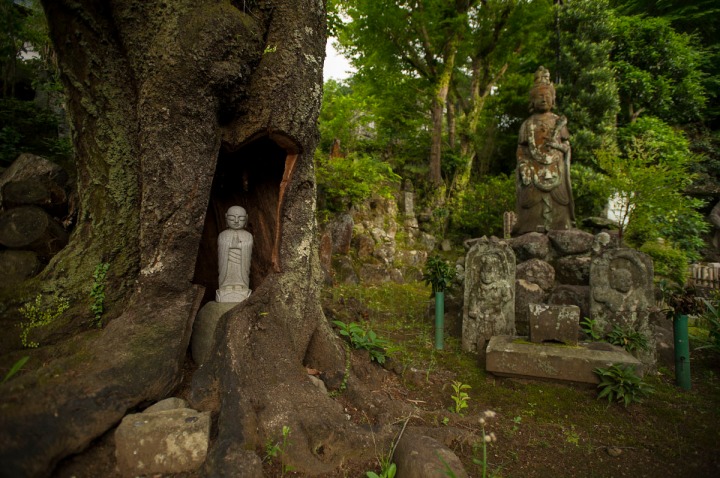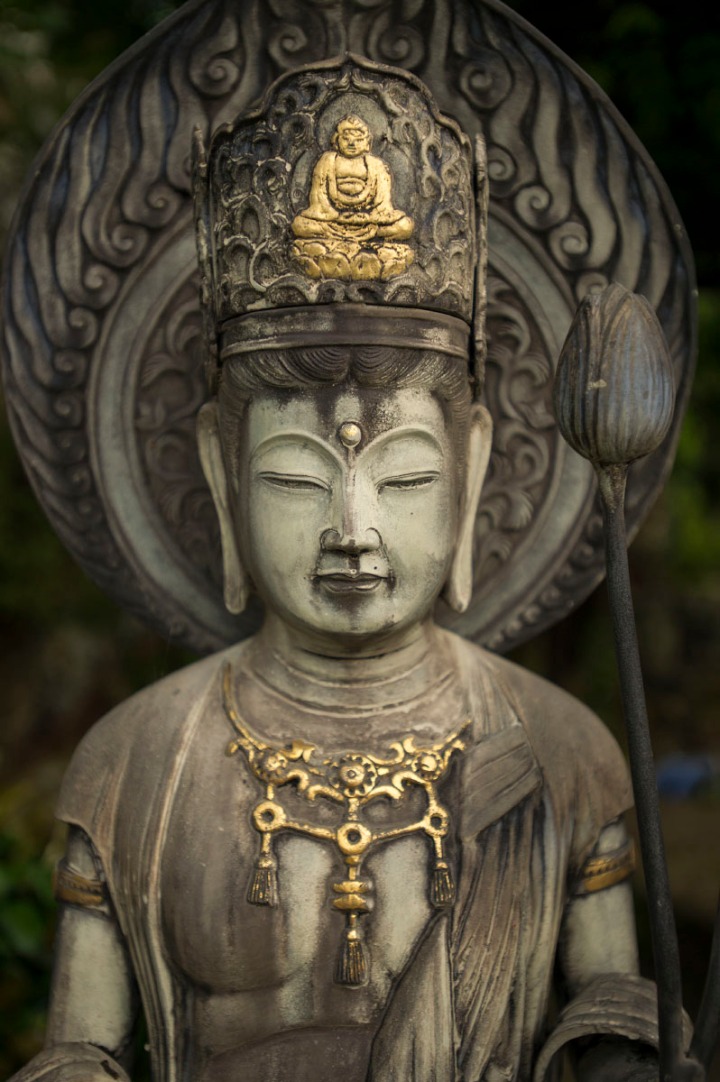Fukusenji Temple – Yugawara
On the western edge of Kanagawa Prefecture (which neighbors Tokyo to the south west) lies Yugawara Town (湯河原町) right between the Pacific Ocean and the glorious hot springs of the mountains. Even in Japan Yugawara is famous for being a town catering to old people, due to the many hot springs who specialize in the elderly and since 2008 the town has no high schools, although three elementary and junior highs. There are quite a few interesting temples in the town though, not least being the pretty little Fukusenji.
Although technically not in Yugawara Town, as the border to Atami City and neighboring Shizuoka Prefecture lies just about 50 meters to the east of the temple, along the Chitose River, it is for all practical purposes completely a Yugawara temple. The main temple building has a gorgeous straw roof which is getting quite unusual these days. Although being more or less loaded with beautiful statues the temple is mostly famous for it Kubi Daibutu, or Big Buddha Head, a rather crude statue of a buddha head! This ceramic head used to be located inside Nagoya Castle but was moved here in 1945.
There is an interesting story behind how the statue came to be, in a legend from the early 17th century. The Daiymo (Lord) of Owari (modern Nagoya) was passing through a town in his grand procession just as a rather deaf lady was taking her bath in front of the family house. Her horrified daughter pushed her mother complete with bath tub and soaps into the house. Seeing this very humble act of daughterly devotion, the Daimyo Tokugawa Yoshinao (1601-1650) forgave the family their indiscretion and commanded her to take up a position as a castle maid. However the Lord’s interest in her were a little bit more rustic, and a year later the poor girl gave birth to a son whom she promptly dispatched of with with the excuse that such a lowly born girl as herself could not possibly be the mother of a child from such an exalted lord. In pity on the girl and the child it was decided that the Buddha Head statue would be created, to remind both the Gods and the Lords of the tragic story (or, unconventional humbleness on the part of the girl).
I might have mistranslated the story, but I think this was what happened. The story was put in very vague terms to say the least! Another explanation, although much less colorful, is that the head was an offering to the spirit of the Daiymo’s favorite son who died at the age of nine.
In the middle of trying to make sense of the legend, I completely failed at finding out just how old the temple itself is!
Yugawara Town is just one stop on the train to Atami, a trip that takes between 90 to 140 minutes from Tokyo, depending on how fast you need to go (with ticket prices to match).
Graves of Gokokuji Temple
The huge Gokokuji Temple in Tokyo’s Bunkyo Ward is interesting not least for its graves of many historically significant persons in Japanese recent history. Not least among them is the statesman and Imperial Court Noble Sanjo Sanetomi (三条実美, 13th March 1837 – 28th February 1891). More well known to Westerns might be the grave of Marquess Okuma Shigenobu (大隈重信, March 11th 1838 – January 10th 1922) whose grave is in the first picture. Both of these men were prime ministers of Japan, Okuma during the first years of the Great War, and both of them have huge stone Torii guarding the entrances to their graves. Okuma founded the schools that would become the famous Waseda University in 1882. He also spoke English and managed to remove the official ban on Christianity in 1873.
I took these photos in the winter a few months ago, but now in summer the cemetery is more spectacularly alive with trees, flowers and birds everywhere.
Gokokuji Taishido – Bunkyo Ward Temple
My favorite building on the massive Gokokuji temple compound in Tokyo’s Bunkyo Ward is without a doubt the relatively tiny Taishido (大師堂). The patina and the robustness of the old wooden building is very attractive for some reason, partly helped by it secluded location on the temple grounds, off to one side. The temple was originally built in 1701 and went by the name of Yakushido (薬師堂) but was moved to its present location and received a new name in 1926 after the large Tokyo fires. From the look of the roof I have a feeling it might been covered in straw in the old days.
Since 1975 the Taishido has been designated an important cultural relic by the Bunkyo Ward office. I wish I could have gotten better photos but there was a very very devout man praying in front of the temple and he made no signs as if he was about to move anywhere soon so I gave up on the project for this time. See, there is a story behind all these images I post. (^-^)
More Gokokuji Temple – Bunkyo Ward
Some more photos of the nearly 400 years old Gokokuji temple in Tokyo’s culture rich Bunkyo ward. I took these a few weeks ago and the trees have yet to shoot any leaves but it was a brilliant day and I seldom pass the area so I took my chance. The tample is located on a simply huge piece of land for being central Tokyo and if you take of your shoes you are free to enjoy the stillness, the sounds and the smells of the main temple building.

































leave a comment